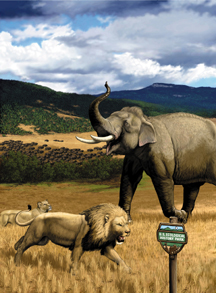 A new mammal
conservation proposal could one day have wild lions, elephants, cheetahs, camels
and horses roaming the American Great Plains. The animals are native to Africa
and Asia but are distantly related to the large vertebrates that went extinct
in North America at the end of the Pleistocene 13,000 years ago, shortly after
humans arrived from Eurasia.
A new mammal
conservation proposal could one day have wild lions, elephants, cheetahs, camels
and horses roaming the American Great Plains. The animals are native to Africa
and Asia but are distantly related to the large vertebrates that went extinct
in North America at the end of the Pleistocene 13,000 years ago, shortly after
humans arrived from Eurasia. Some ecologists propose setting up an ecological preserve in the U.S. Great Plains that would include wild elephants, lions and camels. Illustration by Carl Buell for Cornell; courtesy of Nature.
Josh Donlan, an ecologist at Cornell University in Ithaca, N.Y., and colleagues argue in a commentary in the Aug. 18 Nature that because unrest in Africa and Asia as well as global human impacts are likely to lead to the extinction of many of these species in the next century, people have an ethical responsibility to conserve them globally, including on the Great Plains, a region with a declining human population that could benefit from ecotourism. The goal of the radical plan, Donlan says, is to spark debate in the field of conservation biology and change the objective “from managing extinction to actively restoring natural processes.”
Whereas U.S. conservationists often use the 1492 arrival of Columbus as a benchmark for restoration, Donlan proposes “using ecological history, back to the late Pleistocene in North America, to guide conservation and to restore important ecological function. It provides a much grander and more optimistic view of conservation in North America.”
The proposal, however, has come under much criticism. Eric Dinerstein, chief scientist and vice president of conservation science for the World Wildlife Fund, says that Africa and Asia are “doing a far better job of conserving their big mammals” than the United States is. “It’s really disingenuous to say that populations are under great threat in these countries.”
Donlan says that the conservation effort in North America would not take away from efforts in Africa and Asia. The animals, he says, would come not from abroad, but from captive breeding programs or private game reserves in the United States, and would be introduced on private, well-managed tracts of land, first in Texas and the Southwest where some ranchers are looking for alternatives to cattle. “You can see a cheetah in Texas right now,” Donlan says, but the focus is not on conservation biology or ecology, but rather on sport hunting or tourism.
Past efforts to restore native species, such as wolves and grizzly bears, to North America have faced much resistance, Dinerstein says. Therefore, the idea of introducing nonnative lions and elephants to the Great Plains is likely impractical. “Rewilding is a great idea and we’re doing it,” he says. “It’s just that they [Donlan et al.] are choosing the wrong cast of characters.”
The World Wildlife Fund is currently working with 40 other conservation organizations to purchase 3.6 million acres in eastern Montana to create a national bison preserve. Dinerstein envisions the preserve first being populated with the native descendants of Pleistocene survivors, including bison, pronghorn, elk and deer, and then later with large predators, such as grizzlies, wolves and mountain lions, using the era of Lewis and Clark as an ecological benchmark.
Because the threat of extinction is not likely in the next few decades for the African and Asian species, “we should work really hard at trying to expand the protected areas and the reserve networks of African and Asian countries that are protecting their Pleistocene megafauna,” Dinerstein says. “There’s some really important work ahead of us.”

